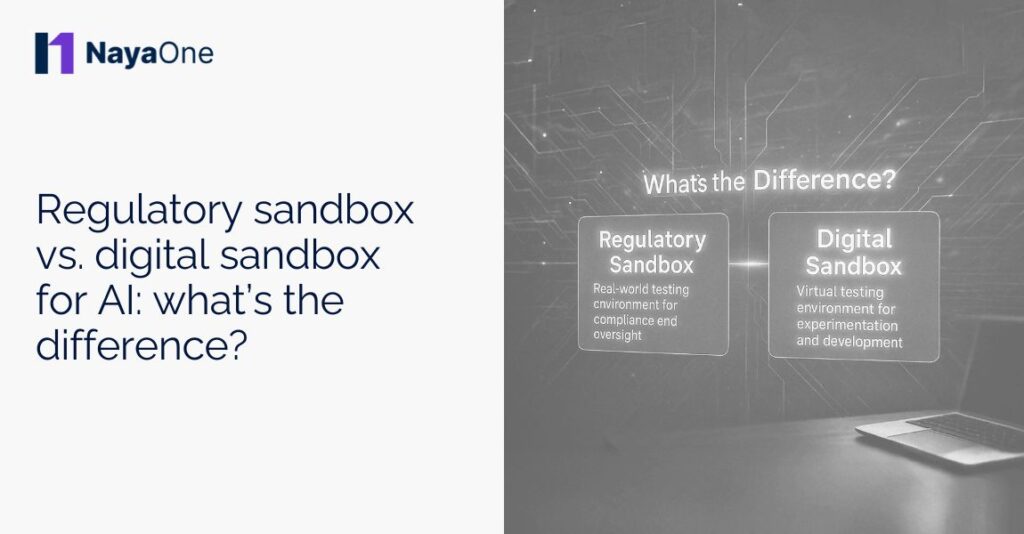Innovation and compliance don’t always make the easiest pair. When you’re experimenting with artificial intelligence inside regulated sectors like financial services, you’re constantly walking a tightrope: stay competitive without stepping outside the lines. In fact, according to a 2024 report by Deloitte, 64% of financial services organisations say regulatory uncertainty is the biggest barrier to scaling AI initiatives.
That’s why the concept of a sandbox has become so appealing. It’s a safe place to test new things, right? But here’s where it gets a bit confusing: not all sandboxes serve the same purpose. Some are designed to let you play by the rules with a regulator looking over your shoulder. Others are built to help you break stuff, rebuild it, run tests, and tweak your models until they’re rock solid, all without getting the legal team involved just yet.
We’re talking about a regulatory sandbox and a digital sandbox for AI. They sound similar, but they serve very different needs. Understanding what each one does and how they can work together is key if you’re serious about AI innovation.
It’s not just an environment, it’s the execution layer that turns technical experiments into enterprise-ready capability.
Let’s unpack the differences.
How does a regulatory sandbox support AI development?
If you’re working with something truly novel, say an AI-powered credit risk tool or a new fraud detection engine, there’s a good chance your compliance team has questions. So does your regulator.
A regulatory sandbox is a framework created by financial authorities, like the UK’s FCA, to let companies trial these kinds of ideas in a limited way. You can release your solution to a small group of real users, within a defined scope, under close supervision. It’s like live-fire testing with a safety net.
This setup is incredibly useful when your AI model or product pushes against the boundaries of existing regulation. Think of biometric onboarding, explainable AI in lending decisions, or algorithmic pricing. These aren’t things you want to roll out widely without first understanding how they’ll be interpreted by a regulator.
But here’s the thing: getting into a regulatory sandbox isn’t quick. There’s usually a formal application process, cohort-based timing, and a fair bit of back and forth. It’s designed for proving legal and ethical viability, not necessarily technical readiness.
Which begs the question: where do you actually build and test the thing before you even apply?
What problems does a digital sandbox solve that a regulatory one cannot?
This is where the digital sandbox for AI really shows its value. Think of it as your innovation lab. It’s where your data scientists, engineers, and product teams get to experiment without having to worry (yet) about customer impact, legal reviews, or regulator scrutiny.
A digital sandbox for AI is a self-contained environment that lets you simulate real-world conditions using synthetic or anonymised data, APIs, and pre-integrated tools. You can trial different algorithms, run fairness checks, assess explainability, and even test integrations with third-party systems, all before a single user ever interacts with your solution.
The beauty of a digital sandbox for AI lies in its flexibility. You’re not bound by regulator timelines or application cycles. You can test multiple ideas in parallel, iterate quickly, fail safely, and pivot without delay. It’s perfect for early technical validation, vendor evaluation, and building internal confidence before taking anything near a regulator or a customer.
This isn’t just about testing code. It’s about testing whether your digital sandbox for AI is robust, secure, fair, and actually useful in a complex financial context.
What does an effective digital sandbox look like in financial services?
A well-designed digital sandbox is more than just a staging area for tech teams; it’s a controlled, secure environment where financial institutions can model real-world complexity without the associated risk.
In a sector where data sensitivity, compliance obligations, and integration requirements are non-negotiable, the ideal sandbox should combine access to synthetic or anonymised datasets, standardised APIs, workflow orchestration tools, and prebuilt connections to relevant FinTech and vendor services. It should also support testing across a range of use cases: model validation, fairness checks, explainability assessments, and simulated integrations with third-party systems.
Crucially, the sandbox should enable both internal teams and external partners to work in parallel, testing ideas, verifying results, and iterating without tripping over procurement, security, or governance hurdles. That means not just giving people access to tools, but orchestrating an ecosystem where experimentation can actually lead to deployable, regulator-ready outcomes.
In fact, according to a 2024 report by the Financial Conduct Authority, the UK’s Digital Sandbox initiative has supported over 100 Proofs of Concept (PoCs) across various financial services sectors, demonstrating the effectiveness of such environments in fostering innovation and compliance.
In short, it’s not just a place to test; it’s a place to prove what works, what doesn’t, and what needs to change before anything goes near a production environment.
Can a digital sandbox accelerate readiness for regulatory engagement?
Absolutely. Just because a digital sandbox doesn’t involve regulators directly doesn’t mean it doesn’t help you work with them more effectively.
When you’re ready to engage with a regulatory sandbox, you’ll be expected to show that your solution has been tested, that you’ve thought through the risks, and that you can operate safely. The UK’s Financial Conduct Authority (FCA) has supported over 630 applications to its Regulatory Sandbox since launch, with many firms leveraging digital sandboxes and innovation labs to prepare their solutions. In fact, more than half of previous participants in FCA’s pilots and TechSprints reported positive developments such as launching new products, securing funding, or gaining industry recognition.
You can generate the kind of artefacts regulators like to see: performance metrics, bias assessments, explainability reports, and integration documentation. You’re not just saying your AI model works; you’re showing that it works under real-world conditions, across multiple scenarios, with clear evidence to back it up.
That puts you in a much stronger position to apply for a regulatory sandbox program or even skip it entirely if your proposition no longer falls into the “untested” category. It’s about being prepared, credible, and fast.
Plus, the digital sandbox doesn’t have to stop when regulatory testing begins. You can keep using it to iterate in the background, test new features, or onboard new data sources while the main application is under review.
Why both sandboxes matter and how NayaOne brings them together
There’s no need to choose between regulatory and digital sandboxes. They serve different purposes and, when used together, form a powerful pipeline for innovation.
Regulatory sandboxes give you the legal green light to trial something in the real world, under supervision. They’re about market readiness and policy alignment. A digital sandbox for AI, on the other hand, gives you the space to break, build, and iterate without consequences. They’re about technical robustness, confidence, and speed.
With NayaOne, you don’t just get a digital AI sandbox. You get the infrastructure layer, what we call the Vendor Delivery Infrastructure (VDI), that lets you build, test, and scale third-party and AI capabilities with full compliance and control.
It’s more than a place to test. It’s how you safely move from prototype to production, without PoC chaos, vendor sprawl, or waiting on procurement. Whether you’re preparing for regulatory engagement or already deploying a digital sandbox for AI solutions, with NayaOne, you can test, validate, and roll out external solutions without delays from compliance or procurement.
So next time you’re evaluating a complex AI or vendor-powered use case, don’t just think about where it needs to go. Think about where it needs to start, and how you’ll scale it across the enterprise. That’s what NayaOne is built for.





